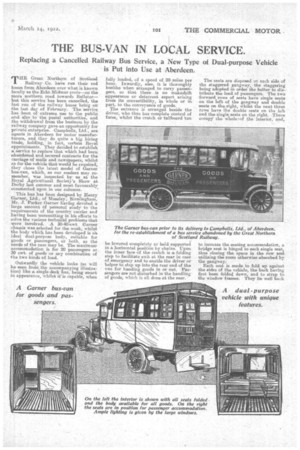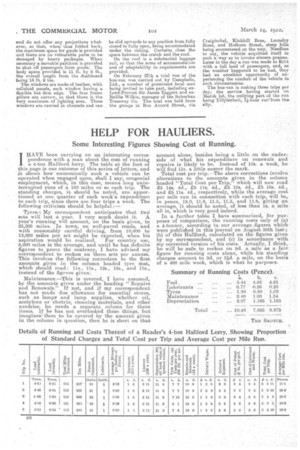THE BUS-VAN IN LOCAL SERVICE.
Page 11

Page 12

If you've noticed an error in this article please click here to report it so we can fix it.
Replacing a Cancelled Railway Bus Service, a New Type of Dual-purpose Vehicle is Put into Use at Aberdeen.
THE Great Northern of Scotland Railway Co. have run their red buses from Aberdeen over what is known locally as the Echt-Midmar route—on the more northern road towards BaBalerbut this service has been cancelled, the last run of the railway buses being ()lithe last day of Vebruary. The service has been of extreme use to the public and also to the postal authorities and the withdrawal from the business by the railway company gave an opportunity for private enterprise. Campbells, Ltd., are agents in Aberdeen for motor manufac, turers, and they do quite a big hiring trade, holding, in fact„ certain Royal appointments, They decided to establish a service to replace that which had been abandoned and secured contracts for the 'earriage of mails and newspapers, whilst as for the vehicle that would be required, they chose the latest model of Cearner bus-van, which, as our readers may remember, was inspected by us at the Royal Agricultural Society's Show at Derby last summer and moat. favourably commented upon in our columns.
This bus has been designed by Henry Garner, Ltd., of Moseley, Birmingham. Mr. J. Parker Garner having devoted a large amount of personal study to the requirements of the country carrier and having been unremitting in his efforts to solve the various techmail problems that were involved. A 30-4,CKewt,. Garner chassis was selected for the work, whilst the body which has been developed is an ideal dual-purpose body, suitable, for goods or passengers, or both, as the needs of the case may be. The maximum accommodation is for 20 passengers or 30 cwt. of goods or any combination of the two kinds of load.
Outwardly the vehicle looks (as will be seen from the accompanying illustration) like a single-deck bus, being smart in appearance, whilst 11 is capable, when
fully loaded, of a speed of 20,-miles per hour. Inwardly, also, it is thoroughly bu.slike when arranged to carry passengers, so that there is no makeshift appearance or deterrent aspect arising froth its convertibility, in whole or in part, to the conveyance of goods.
The entrance is arranged beside the driver, who thus has complete control of fares, whilst the cratch or tailboard an
be lowered completely or held supported in a horizontal position by chains. Upon the inner face of the cratch is a folding step to facilitate exit at the rear in case of emergency and to enable the driver or helper to step up into the rear end of the van for handing goods in or out. 'Pas.sengers are not disturbed in the handling of goods, which is all done at the rear. The seats are disposed or, each side of the staggered gangway, the staggering i being adopted n order the better to distribute the load of passengers. The two .forward 'rows of seats have single .seats on the left of the gangway and double seats on the„right, whilst the next three rows have the double seats on the left and the single seats on the right. These occupy the Whole of the interior, and,
to increase the seating accommodation, a bridge seat is hinged to each single seat, :thus closing the space in the row and utilizing the room otherwise absorbed by the gangway. Each seat is made to .fold tip against the aides of the vehicle, the back having first been folded down, and to strap to the window frames. They lie well back
and do not offer any projections Whatever, so that, when thus folded back, the maximum space for goods is provided and thereare no vulnerable parts, to be damaged by heavy packages. When necessary a. movable partition is provided to shut off passengers from goods. The body space provided is 11 ft. by 6 ft., the overall length from the dashboard being 14 ft. 8 ins.
The windows are made of leather, with celluloid panels, each window having a flexible hut firm edge. The four frame pillars are narrow, so that there is the very maximum of lighting area. These windows are carried, in channels and can
be slid upwards to any position from fully closed to fully open, being accommodated under the ceiling. Curtains. close the space between the crutch and the roof.
On the roof is a substantial luggage rail, so that the acme of accommodation and of adaptability to requirements are provided. On February 27th a trial run of the bus-van was carried out by Campbells, Ltd., a number of prominent local men being invited to take part, including exLord-Provost Sir James Taggart and exBaillie Wilkie, manager of the Suburban Tramway Co. The trial was held from the garage in Bon Accord Street, via
Craiginchel, Kinkhill Brae, Laundry Road, and Holborn. Street, steep hills being encountered on the way. Needless to say, the vehicle acquitted itself in such a way as to invoke sincere praises. Later in the day a ran was made to Echt with a full load of passengers, and, as the weather happened to be bad, they had an excellent opportunity of experiencing the comfort of the vehicle in such circumstances.
The bus-van is making three trips per day, the service having started on March let, the outlying part of the run being Tillybirlech, 1i-hour run-from the city.




























